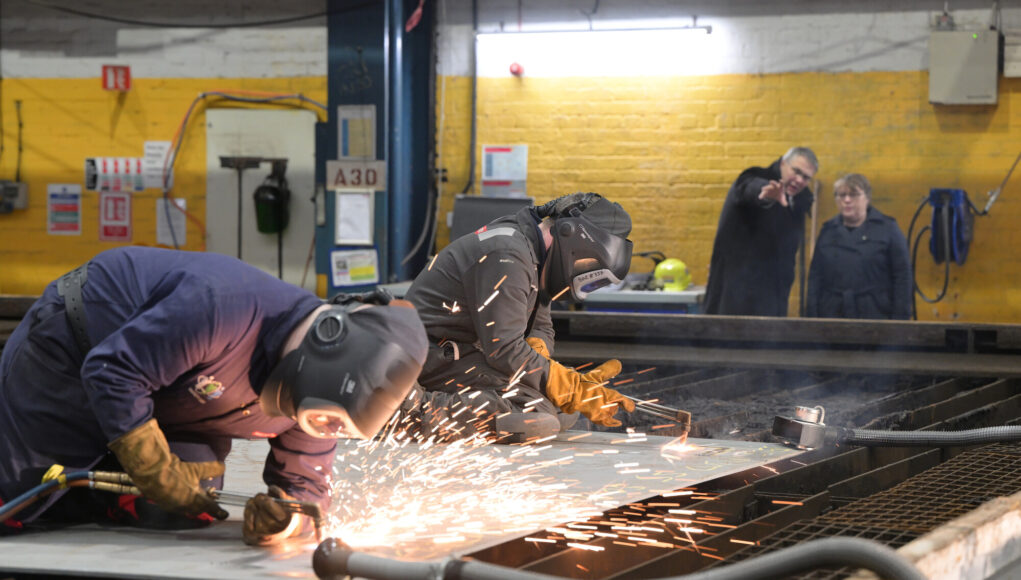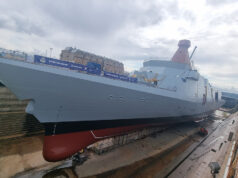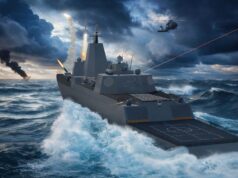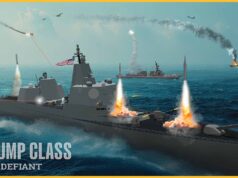The Royal Navy’s ambitious Type 26 frigate programme marked another milestone today as construction officially began on HMS Sheffield, the fifth of eight planned City Class warships.
The ceremonial steel cutting took place at BAE Systems’ Govan shipyard in Glasgow, performed by 27-year-old Apprentice Fabricator Burner Michael Miller. The project, part of a larger programme to deliver eight advanced warships, is sustaining nearly 2,000 jobs in Scotland and 4,000 across the wider UK supply chain, hitting home the sector’s critical role in supporting skilled employment.
Attending the ceremony, Minister for Defence Procurement and Industry Maria Eagle spoke on the economic and strategic importance of the programme:
“HMS Sheffield represents not just a cutting-edge addition to our fleet, but also demonstrates our commitment to supporting thousands of skilled jobs and economic growth across Scotland and the wider UK. This investment in our naval capability ensures we can continue to protect our nation’s interests while supporting British industry.”
The Type 26 frigates, among the world’s most advanced warships, are designed primarily for anti-submarine warfare and high-intensity air defence but are versatile enough to support humanitarian missions.
These vessels are integral to the Royal Navy’s modernisation, replacing the ageing Type 23 fleet. HMS Sheffield follows HMS Glasgow, Cardiff, Belfast, and Birmingham, which are at various stages of construction on the Clyde. The first in class, HMS Glasgow, is expected to enter service by 2028.
BAE Systems continues to invest in its Glasgow facilities, including a £12m Applied Shipbuilding Academy and the Janet Harvey Hall, a state-of-the-art shipbuilding facility named after a World War II electrician.
Simon Lister, Managing Director of BAE Systems’ Naval Ships business, praised the teams behind the project:
“HMS Sheffield’s construction will benefit from a range of investments, transforming our digital and physical infrastructure and consolidating a centre of excellence for UK shipbuilding in Glasgow. This is a proud moment for our talented teams across the UK.”
The programme also has a global dimension, with Australia and Canada adopting the Type 26 design for their own navies. Lessons learned across the three nations’ 32-ship programme will enhance efficiency and capability.
At the UK Defence Journal, we aim to deliver accurate and timely news on defence matters. We rely on the support of readers like you to maintain our independence and high-quality journalism. Please consider making a one-off donation to help us continue our work. Click here to donate. Thank you for your support!













Going to need more than eight type 26s. HMG needs to add back onto the programme another 2-4 ships.
Agreed, a clear need for four more T26’s and four more T31, to put minimum mass back…
Add 9 replacements for the T45 and we will reach 30 Escorts, a number we should never have dropped below.
Alas we probably dont have the crew numbers for that. We should probably long lead time those ships though, so the yards actually have something to do once this burst of work finishes
Given the glacial pace of construction you can train crews in 7 years….just needs recruitment -> training -> pay and condition -> accommodation -> retention to be sorted…..
They didn’t seem to think they could train crews for Albions in 6-7 years time, no sign of the situation improving
I hardly think the term “churn” applies to British shipbuilding as per the headline.
Babcock seem to think they can get the crew down to 50 on the T32 so it could I be that new ships save us on manning.
Way too low for a lot of the duties frigates do. For dedicated carrier escorts might work though
Type 32? Is that still a thing?? Heard neither sight nor sound about it in ages!
Should the RN have 30 surface combat ships, yes. Can the UK afford 9 T83s to replace the 6 T46s, probably not. What we could do is a bit diffrent but get us a fleet that is flexible. To replace the 6 T45s we could order 3 T83s with 96-112 missile cells, Sejong the Great would be a starting point for the design and 6 AAW T26s, call them T46. The AAW version of the T26 would have the forward Sea Ceptor cells replaced with Mk41 giving 5 blocks of Mk41s and the 24 CAAMs midships. If the 5 inch was replace with a 57mm then six blocks of Mk41s should be possible. Artisan radar and mast would be replaced with an intergrated mast for an upgraded SAMPSON and a four plane fixed array SMART L MM/N such as Sea Fire. That gives an extra three extra surface combat ships. Then the next program would be the T32s, these should be Muti Role Combat Vessels, the Babcock concept of a stretched T31 is a good start point. Each able to land 120 Marines, I for one would prefer the Damen Crossover Combattant concept is a better all round vessel. If we go for the Babcock design which makes in many ways more sense then a further 6 of these ships could be ordered.
There are two valid issues cost and manning. So first lets look at cost of build, by reducing the number of T83s from 6 to 3 the cost is reduced by 50%. Yes 50% the reason for this is that the second build the AAW T26 would have the same radar, engine etc as the T83 but a reduced missile load and command and control capability. As each T83 would cost somewhere in the region of £1.5-1.7 billion that would be a saving of £4.5-£5.1 billion for the three ship reduction. This saving would then be spent on the AAW T26 as she would be AAW then its T46, as they would cost about £1 billion each it would mean a extra £1.5 billion would need to be found to increase the fleet numbers by three further ships. Also by keeping the T26 ASW capability in the AAW version we have increased the fleets tails by six hulls. The diffrence in cost between the ASW and AAW T26 would be the extra Mk41 blocks and the radar/intergrated mast.
That gives a fleet of 22 ships, 14 ASW tails and nine AAW ships with three command ships. The on duty carrier has three AAW ships, two with a tail and the UK has three AAW ships for GBAD with BMD capability, with a further three in refit. Not bad for an extra £1.5 billion, so, so far so good.
Now comes the major investment the T32 and the MRSS vessels. We will start with the requirements for the MRSS. With the decommissioning of Ablion and Bulwark the Royals need a platform for 250 Marines. That means a well deck for two LCVPs or 1 LCU, boat bays for four CB-90s type boats and four helicopters ( two Merlins and two Apaches). The ship would need a speed of 25 knots to keep up with a carrier group which would mean two RR MT30s plus four MTU 8000 series. The ships should also have two RAS postions one for solid stores and one for fuel so they could act as auxillery replenishment ships. These ships should also have an extensive workshop and medical capabilities as well as a gym, sauna, theatre and NAAFI bar. Remember the guys could be forward deployed for some time and the ships would be ‘motherships’ for the escorts, the crews of the escorts need a break. I don’t know why but I keep coming back to the Dokdo or Trieste class as the base design.
The escorts would be the T32s. As I said I like the Damen Crossover however, this would be not cost effective. So the Babcock stretched T31 it is, as most of the ship would be the same as the T31 I would think that they would cost about £150million more so a total build cost of £2.5-£3 billion for six ships. If they could have 2 blocks of Mk41s and 24 CAAM cells midships that would be good.
With three MRSS and 6 T32s that would give three Amphibious Response Groups, one in the Southern Hemisphere, one in the Northern and one in refit/repair etc. Each group could land up to 400 Marines in a single lift and a follow on of about 100 and a further 100 in surge capacity. So for an extra £4.5 billion we have increased the fleet by 9 surface combat ships and a further £1.5 billion for the three MRSS. A further 3-6 MRSS should be built with reduced speed and reduced amenities.
The T46 the way I think is not a T83. The T83 would have Admiral staff and be the command and control ship for the carrier escort group, she would carry up to 112 Mk41 cells and be about 12,000 tons. She would have AAW BMD area defence ASTER, local Air defence CAAM Anti Ship and Land Attack capability FCASW. The T46 would be AAW area defence ASTER with five blocks of Mk41 forward, local air defence 24 CAAM midships, Anti Ship NSM and ASW capable able to act as a ASW squadron flagship e.g. with 2 T26s but her main task is to operate with the carriers in the AAW area defence and ASW role. The T26s are ASW with local air defence.
Yes it sounds expensive yet again maybe not. If BAE and Babcock were told now that they have the follow on orders for the T46 and T32 then the long lead items could be ordered such as engines, gearboxes, radars etc. As these would be the same as the current run then production of these items need no design, tooling etc. Saving money and time. If BAE and Babcock knew that they have a continuation order then the workforce will not be forced to relocate and the companies will not need to reemploy and retrain, again saving time and money.
I also agree with Supportive Bloke as this expansion to the fleet would take time we could recruit and train crews. Yet with new ships and better conditions I could see that more people would like to join the RN. By the way people do not always do a job because of the money but because they feel that the job is worth while doing, that also means being respected for the job they do.
So fantisy fleet, I don’t know, we are planning the T83, and MRSS, we are talking about the T32 so these are not ship types that are not in some form being thought about. What I have tried to do is have cost effective solutions to improve hull numbers and give the surface fleet flexibility. If I wish to have a fantisy fleet I would include in the numbers 4 HMAS Canberra type ships, 4 not three MRSS and 8 not six T32s to form four Amphibious Assault Groups. Two groups per carrier. Yet the 4 Canberra LHDs would cost the UK the same as one QE carrier so not a bad return for the flexibility. It’s just wishful thinking.
As for the sub fleet I am not sure, do we need a SSN to clear the path for our SSBNs leaving or coming into the Clyde? I am not sure on that it seems a bit over kill. Can we afford SSNs and AIP subs not really, can we afford only SSNs with 3-4 VPMs not sure. I seem to remember numbers such as 12-15 SSN-AUKUS for the RN, I also seem to remember that they will have payload modules. Can we afford 12-15 subs with 3-4 VPMs, do we need them. No. What I suggest is the 4 SSBNs, 4 SSNs with 4 VPMs and 8 SSNs. The VPM sub would escort the carrier and carry out deep strike land attack, 2 on hunter killer duties. That the Aussie want SSNs with 4 VPMs I can understand and it works for them due to the Pacific being a huge ocean that you can hide in. The RN has a more confinded area of operations for their SSNs, North Atlantic, Norwegian Sea, GIUK Gap, in this case the hunter killer role is more important. However, that would be an extra £9 billion+ for the 5 extra subs. Then again when I look at cost we do seem to get good value for money in our subs.
I do wonder if a more cost effective solution to sanitise the SSBN route incoming and outgoing would be a corvette with a good tail? The total expected cost of 3 T83s, 6 T46s, 3 MRSSs and 6 T32s would be £16.2 billion. The cost of 6 T83s would be 10.2 billion. So for the extra £6 billion I have increased the fleet numbers by 9 surface combat ships and 3 MRSS ships. Now for the extra cost of wishfull thinking, of 4 LHDs, 8 T32s and 4 MRSS ships an extra £4.2 billion above the £16.2billion. If the complete project was to be completed including my wishful thinking then the Uk government would need to invest into new ship construction above the current spend of about £3 billion per year for 8 years. It would give work to thousands if not tens of thousands until the mid 2040s. Who knows because of the drum role we might even get more exports.
This would not include submarines as I do not know enough about cost and tech.
Yet when I look at the cost, and the return it would make the UK one of the most powerful nations at sea. With my wishful thinking of 4 LHDs we could land 4 armoured battlegroups anywhere we need, giving the Army a flexibility they have not had in 80 years. As well as being able to launch up to 100 F35Bs from all six decks and 60 Merlin helicopters as well as 4000 troops, 56 MBTs, 48 artillery units and 1760 Royals. Again anywhere in the world where we need to. We would be able to deal with the Russian navy with the aid of our European allies without the US Navy and have a GBAD capability that we do not as yet have.
It means a Falklands would never happen again, Norway would be reinforced with up to 8,000 troops within 96 hours, the UK has a mobile air defence and that the UK can stop Russia from breaking into the Atlantic, whilst having the ability to carry out offensive strikes. Not a bad return on the £3billion per year for 8 years extra cost of new equipment. Also remember that about 40% comes back to the government in tax.
Idea and rant over, Sorry.
Just an extra point, T31 is a much more suitable platform than T26 for adaptation to AAW. You can fit a rotating SMART-L MM and fixed mast of any S-band panels, maybe CEAFAR. You don’t have to think about the mission bay, which doesn’t really work alongside AAW, and there’s more room for future upgrades. Then you end up with something more like the AA FREMM design, and they cost less as well.
More T26s for me trumps T32. They don’t even need full tails, give them a stern ramp and containerised tails and you get the original genuine Global Combat Ship with very little of the ship changed. Global cruisers (in the mission sense of the term) that can contribute to ASW more than most other frigates globally without the cost of a new design.
Agree with you re T83, only the length of the new Build Hall limits tonnage to c.10,000 and length to 180m. That gives you a large cruiser, only I would have 4 of them so that 2 accompany the working carrier.
Not sure about MRSS or SSNs, not my area of interest, but there’s my personal fantasy fleet.
Babacock does have a AAW variant of the arrowhead 140 on their config site. I think it had 68 cells.
Where do you get the cell number from? I’ve checked the website but can’t find any hard number given.
You can have max 48 mk41 on the Arrowhead hull, 32 amidships and 16 in B position.
I don’t know whether, by deleting the two boat bays either side of the amidships space (so you have only the one sea boat) you could fit in extra ExLS cells or even mushroom farms to the sides like on the Iver Huitfeldt and bring the total up.
by then we’ll all have died of old age the fleet Will NOT GROW until the 2040’s.
Yes, not sure I would describe current pace as ‘churning out’
is it April fools already? churning out it’s a disgrace and the Clyde should be told in no uncertain terms that their performance is unacceptable.
not going to happen we’ve got half lined up for the scrapyard the R.N will lose the type 23 faster than we can comission new ones..just so sad.
How is the type 26 frigate program ambitious, only 8 compared to 16 type 23 and built at a glacial pace
The ambition is to outlast 7 or 8 prime ministers without any being cancelled or sold.
And also nearly double the size of a T23.
Numbers still matter, that mistake was made with the T45. Although 1 T45 could essentially do the same job as 2 type 42s ( and more) it can still only be in 1 place and the 2 T42s can be in 2 places and if the one T45 breaks you have no ships but if one of the T42 breaks you still have 1 ship… also radar horizons mean two ships will always provide better radar cover than one..even if it has better sensors…it still cannot look through the sea.
Churned out is not a phrase I would use to describe this situation were not one ship has even gone out for trials
Churned out suggests speed of delivery.
Which we are not seeing. But, we could.
I’d be happier if tails on T26 and T31 were progressing at pace.
Yes at the present pace the RN will likely drop to a low of 11 escorts.
“Churned out”? Hardly, the Chinese churn out. Scotland bumbles. Think “ferry”.
Small numbers at a snails pace isn’t my idea of churning out or ambitious!
Welcome to the future fleet Sheffield, may your future be as glorious as your WW2 namesake. Now can we have a few more of these well designed ships and a bit quicker of the production line. How about BAE speeding up construction and the UK government paying a fixed sum per year, so say £1.2 billion per year for 15 years. Then this is what we need and this is the time frame we need it. Only on the condition that the next ships are in the pipe line.
The UK Government also needs to make a regulation, no ship apart from capital ships such as carriers LHDs etc should be more than 20 years old. That would mean for example if a destroyer takes 7 years to build then she needs to start construction when the active ship is 13 years old.
This then means that we could sell a ship that has a further 10-15 years of front line service, we recope a better return on said ship, we have a modern fleet, we could if need be or we think it is a good idea give some of the ships to the RNR as the reserve fleet. Most important we would have a modern fleet, with no life extention program cost thereby saving money.
How to pay for such a fleet, how about 1% import tax on all goods go to the fleet for new ship build. If I remember my history correct the Germans at the turn of the 20th C had a Sekt tax (sparkling wine) that help pay for the High Seas Fleet. They did not complain.
You don’t need to tax anyone extra to achieve this. You just need to defeat the Treasury’s cynicism. The Treasury’s failure to offset the build’s currently imposed taxes, makes building in the UK seem more expensive than it is.
If you keep building, the cost per unit drops, there’s no need to lose and restore workforce. Because you are selling early, the fleet is on average far younger, availability increases, maintenance costs are lower, operation costs are lower, emissions are lower (which matters to Labour). If you manage to get sales, the overall build costs netted against the amount of tax the Treasury recoups from building are not that much higher than the cost of stop-start building of fewer ships. If you also get additional exports, UK Plc moves into profit.
So all the Treasury needs do is count differently, not tax more. Company car fleets are managed this way, with constant purchase and resale, and nobody bats an eyelid.
T23 was supposed to work like that, we’ve clearly abandoned that idea
The Treasure resents spending on defence, according to a former Treasury manderin who was recorded for TV (can’t remember which channel).
I would pass a law that required all Government spending took into account direct tax returns on spend but also credits secondary economic impacts, etc. spending in local shops. The Treasury already has a evidenced process/formula for doing this and it is quite happy for other sectors to use it, so why not defence?
In the UK 1% of the work force is employed in Primary industries (farming, mining, etc.), 9% are involved in secondary industries and 81% tertiary employment (shops, lawyers, etc.) with the rest employed in research and development. So spending any spending in defence that drives money into the local economy can support a huge number of jobs in the tertiary sector. This is process is reasonably well understood although difficult to measure, as I say, there are processes and formula out there that can provide acceptable ball park figures.
Cheers CR
PS Percentages above are from online A level study materials 🙂
How many years will Glasgow have been in the water before reaching service? Probably longer than any T45 has actually done on the job.
Well she’s only floating in a dock currently, be in there for 1 or 2 more. Then sea trials
Ok, the hull fabrication processes seem to have sped up for both BAE and Babcock, but the fitting out processes are still too slow.
As well as the time spent on building and fittting, we then have sea trials which will absorb even more time.
More investment and more resources needed.
Churn is a great English word which has F.A. to do with ships or boats. 😀🏴☠️❤️✌️